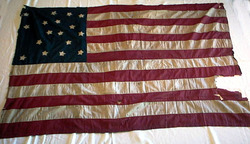

Obverse - edit
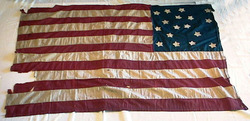
Reverse - edit

Obverse
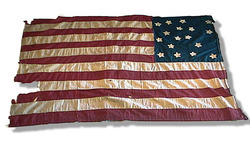
Reverse
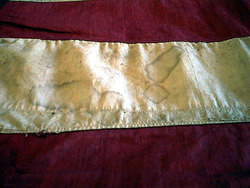
Obverse Detail
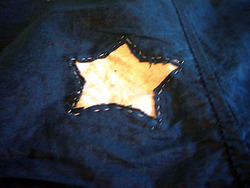
Obverse Star
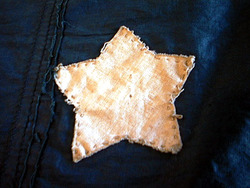
Reverse Star
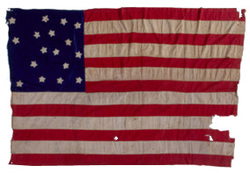
Book Photo

Obverse
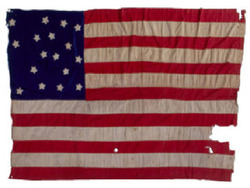
Obverse - edit 2
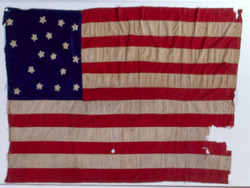
Obverse - edit 3
U.S. 17 Star Exclusionary Flag.
Sub-collection: Star Spangled Banner Flag House17 Star U.S. Northern Abolitionist Exclusionary Flag, 1858 - 1859.
Flags bearing 17 stars and 13 stripes were never an official flag of the United States; however numerous surviving examples confirm both their existence and use. Seventeen star flags were made to indicate the admission of Ohio as the 17th state on March 1, 1803; and period flags would remain accurate until the admission of Louisiana on April 30, 1812; a period of 9 years, 1 month and 27 days.
It is known that the United States Indian Department ordered seventeen-star, seventeen-stripe flags in the year spanning 1804-1805. Privately made flags from the same era also tended to reflect the consensus that all of the states be represented in the U.S. flag.
This 17 star flag's early history is unknown; but it was formerly part of the collection of The Flag House & Star-Spangled Banner Museum. Founded in 1927, it is one of Baltimore's oldest museums open to the public. The Star-Spangled Banner Flag House Association, Inc. was formed in 1927 to operate a museum dedicated to the story of Mary Young Pickersgill who made the enormous 30 x 42-foot Star-Spangled Banner that flew over Fort McHenry during the War of 1812 and inspired Francis Scott Key to write the poem that became our National Anthem.
Mary Pickersgill's flag still survives and now hangs at the Smithsonian Institution's National Museum of American History. As one of the earliest institutions dedicated to the study of flags, The Flag House & Star-Spangled Banner Museum also became a repository for flags from other eras, and amassed one of the largest flag collections in the nation.
The materials used in the manufacture of this flag are inconsistent with other period 17 star flags. Most notable is the use of machine sewing for the stripes. Instead it is likely that this is an abolitionist exclusionary flag. The Fugitive Slave Act passed as one of the elements of the Compromise of 1850 allowed slave catchers to roam the North in search of anyone who had escaped slavery. The presence of these individuals in New England particularly enraged abolitionist elements there, with some extremists going so far as to advocate Northern secession from the Union rather than submission to the outrages of the Fugitive Slave Act. Exclusionary Stars and Stripes made during the period from 1850 to 1860 reflected that sentiment. Such flags featured stars only for the free states, excluding the 15 slave states from the total represented. This 17-star flag, therefore, is thought to date from around 1858-1859, when 17 free and 15 slave states formed the Union.
This flag has a scattered arrangement of stars which appear with the blue material cut out to show the stars on both sides. In contrast to the expected dates (from 1803, when Ohio became the 17th state, until 1812 when Louisiana became the 18th), the Smithsonian estimates the flag to date between the 1860s and the 20th century. Howard Madaus states that it is an Exclusionary Flag representing the abolitionist movement (1840s to 1850s) or a very early Confederate provisional (CSA) flag.
Exhibition History:
First Presidio Exhibit
(ZFC0022)
17-Star United States "Exclusionary Flag"
Second Presidio Exhibit, 2003 Gallery III
(ZFC0022)
17-Star United States "Exclusionary Flag"
Publication History:
Madaus, Howard M., Dr, Whitney Smith, The American Flag: Two Centuries of Concord and Conflict. Santa Cruz: VZ Publications, 2006, p. 59.
Provenance:
• Mrs. Mary Gertrude Deck King, Baltimore, MD, until 1975.
• Gifted to Star Spangled Banner Flag House & Museum, Baltimore, MD until deaccession, 1996.
• Acquired by private treaty by the Zaricor Flag Collection, 1996.
ZFC Significant Flag
Sources:
Madaus, Howard M.- Whitney Smith, The American Flag: Two Centuries of Concord and Conflict, VZ Publications, Santa Cruz, 2006.
Mastai, Boleslaw and Marie-Louise D'Otrange, The Stars and The Stripes: The American Flag as Art and as History from the Birth of the republic to the Present, Knopf, New York, 1973.
Preble, George Henry, The History of the Flag of the United States of America, Boston, Houghton, Mifflin & Co. 1894.
Image Credits:
Zaricor Flag Collection
Hoist & Fly | |
|---|---|
| Width of Hoist | 69 |
| Length of Fly | 46 |
Union/Canton | |
|---|---|
| Width of Union/Canton | 24 |
| Length of Union/Canton | 22 |
Stars | |
|---|---|
| Comments on Star Measurements | Reverse : 2.5" |
| Size of Stars | 2 |
Stripes | |
|---|---|
| Width of 1st Stripe | 3.5 |
| Width of 3rd Stripe | 3.5 |
| Width of 8th Stripe | 3.5 |
| Width of Last Stripe | 4 |
Frame | |
|---|---|
| Is it framed? | yes |
| Frame Height | 60 |
| Frame Length | 96 |
Stars | |
|---|---|
| Number of Stars | 17 |
| How are the stars embeded? | Sewn |
| Are there stars on obverse? | yes |
| Are there stars on reverse? | yes |
Stripes | |
|---|---|
| Number of Stripes | 13 |
| Color of Top Stripe | Red |
| Color of Bottom Stripe | Red |
| Has a Blood Stripe? | no |
Nationality | |
|---|---|
| Nation Represented | United States |
Fabric | |
|---|---|
| Fabric | Cotton |
| Comments on Fabric | Fabric appear to have been re-used, white appears to be old sheeting |
Stitching | |
|---|---|
| Stitching | Machine |
| Comments on Stitching | Stars hand stitched |
Thread | |
|---|---|
| Thread Material | Cotton |
Condition | |
|---|---|
| Condition | Bad |
| Damage | Flag contains holes and some tare on the right side. |
| Displayable | yes |
Date | |
|---|---|
| Date | no earlier than 1860's (could be 20th century) |
Exhibits | |
|---|---|
| Exhibition Copy | First Presidio Exhibit (ZFC0022) 17-STAR UNITED STATES "EXCLUSIONARY" FLAG Date: About 1858-1859 Medium: Cotton; machine-stitched except for hand-stitched stars Comment: This flag, with its 17 stars, would seem to have been made between Ohio's admission to the Union in 1803 as the seventeenth state and Louisiana's achievement of statehood in 1812. However, the fact that the stripes and canton of the flag are machine-sewn precludes its having been manufactured before 1850. They suggest that it is, instead, an abolitionist "exclusionary flag." The Fugitive Slave Act – passed as one of the elements of the Compromise of 1850 – allowed "slave catchers" to roam the North in search of anyone who had escaped slavery. The presence of these individuals in New England particularly enraged abolitionist elements there, with some extremists going so far as to advocate Northern secession from the Union rather than submission to the outrages of the Fugitive Slave Act. Exclusionary Stars and Stripes made during the period from 1850 to 1860 reflected that sentiment. Such flags featured stars only for the free states, excluding the 15 slave states from the total represented. This 17-star flag, therefore, is thought to date from around 1858-1859, when 17 free and 15 slave states formed the Union. Provenance: Acquired by the Zaricor Flag Collection (ZFC0022) in 1996 from the Star-Spangled Banner Flag House Collection of Baltimore, MD. Second Presidio Exhibit, 2003 – GALLERY III (ZFC0022) 17-Star United States "Exclusionary Flag" Date: About 1858–1859 Medium: Cotton; machine-stitched except for hand-stitched stars Comment: This flag, with its 17 stars, would seem to have been made between Ohio's admission to the Union in 1803 as the seventeenth state and Louisiana's achievement of statehood in 1812. However, the fact that the stripes and canton of the flag are machine-sewn precludes its having been manufactured before 1850. They suggest that it is, instead, an abolitionist "exclusionary flag." The Fugitive Slave Act-passed as one of the elements of the Compromise of 1850-allowed slave catchers to roam the North in search of anyone who had escaped slavery. The presence of these individuals in New England particularly enraged abolitionist elements there, with some extremists going so far as to advocate Northern secession from the Union rather than submission to the outrages of the Fugitive Slave Act. Exclusionary Stars and Stripes made during the period from 1850 to 1860 reflected that sentiment. Such flags featured stars only stars for the free states, excluding the 15 slave state stars from the total. This 17-star flag, therefore dates from around 1858-1859, when 17 free and 15 slave states formed the Union. |
Publications | |
|---|---|
| Publication Copy | Publication History: Madaus, Howard M., Dr, Whitney Smith, The American Flag: Two Centuries of Concord and Conflict. Santa Cruz: VZ Publications, 2006, p. 59. "17-Star United States Exclusionary Flag This flag, with its 17 stars, would seem to have been made between Ohio's admission to the Union in 1803 as the seventeenth state and Louisiana's achievement of statehood in 1812. However, the fact that the stripes and canton of the flag are machine-sewn precludes its having been manufactured before 1850. They suggest that it is, instead, an abolitionist exclusionary flag. The Fugitive Slave Act-passed as one of the elements of the Compromise of 1850-allowed slave catchers to roam the North in search of anyone who had escaped slavery. The presence of these individuals in New England particularly enraged abolitionist elements there, with some extremists going so far as to advocate Northern secession from the Union rather than submission to the outrages of the Fugitive Slave Act. Exclusionary Stars & Stripes made during the period from 1850 to 1860 reflected that sentiment. Such flags featured stars only for the free states, excluding the 15 slave states from the total represented. This 17-star flag, therefore, is thought to date from around 1858-1859, when 17 free and 15 slave states formed the Union during the presidency of James Buchannan |
| Flag Books | |








